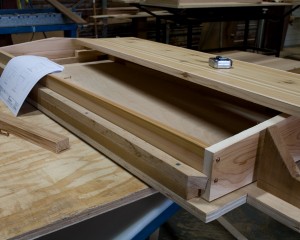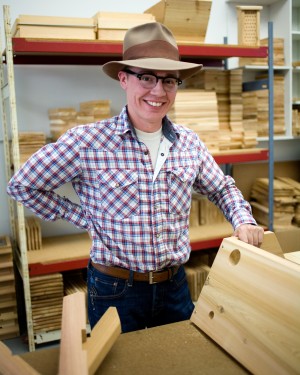Bee-Thinking owners Matt and Jill Reed began keeping bees after feeding honey to a honeybee one day in 2008. Today, the two craft top bar and Warre beehives for beekeepers all over the world. Read on for Matt’s reflections on the philosophy behind their craft, the benefits of keeping bees and why their hives will outlast the rest.
How did Bee-Thinking get its start? What led you to start constructing beehives?
It all started in 2008 when a honeybee landed in our kitchen on a chilly, gray day. I fed it some honey and took it outside, its energy was restored and it flew away. Later, my wife, Jill, was leaving for work and dozens of bees were flying into our screen door trying to get inside. Obviously that bee had communicated to the rest that there was a great food source inside! A month later we bought our first hive.
That year, I spent the entire winter building top bar hives and Warre hives for myself, blogging about the entire process. Soon I was getting inquiries from people all over the country, wondering how they could get one of my hives. Thus, Bee-Thinking was born.
What is the philosophy behind Bee-Thinking products?
From its inception, our goal at Bee-Thinking has been to use and promote natural beekeeping methods. By this we mean providing the bees with an ideal cavity in which to live, with minimal disturbance to the hive by the beekeeper. We do not promote the use of chemicals or medication of any sort, believing instead that healthy colonies come from good genetics, letting strong colonies thrive. We are open to all hive designs, knowing that there is a long tradition of creativity in hive sizes and shapes through the centuries and that bees in nature are highly adaptable and often pick surprising places to build their colonies. The point is that bees know better than we do what they need and how to thrive.
What makes your products unique? What are top bar hives and Warre hives? What are the advantages of each?
Our products are ideally suited for backyard and hobby beekeepers looking for hives that are functional and fun. Our hives are some of the only ones built in the United States from Western Red Cedar. Our hives will far outlast the pine hives which are commonly sold elsewhere. The biggest difference between our hives and the more predominant Langstroth hives is that in ours, the bees are allowed to build their own natural combs, without any frames or commercially pressed wax foundation. In our experience, bees prefer to build their own combs and they do so very quickly. Not only that, but the manufactured wax foundation used in most hives has been studied and proven to harbor numerous pesticides and insecticides, even while on the store shelf! Finally, honey-harvest is easier with our hives, as the beekeeper does not need an expensive extracting machine. Instead, the honeycombs can be cut into squares, or crushed and strained with regular household mason jars and cheesecloth.
Top bar hives and Warre hives are both technically top bar hives, as they use bare wooden bars laid across the hive cavity from which the bees draw their combs. The full name of our top bar hive is horizontal top bar hive, or Kenyan top bar hive. These are long hives featuring 28 top bars laid across the hive cavity from which the bees build their own combs. Each of our top bar hives has a viewing window through which the colony can be observed and monitored.
The Warre hive was invented by a French monk in the early 1900s. He called his hive “The People’s Hive,” as he thought it was ideally suited for most people for its simple management and construction. Like the horizontal top bar hive, the Warre hive uses top bars, but 8 bars in each of its stacked boxes. The bees start in the top box and continue building downward through the empty boxes below, much like bees do while living in trees or other natural cavities.
When I began my beekeeping adventure I had never built anything. Shortly after I began building hives, I took woodworking classes in Portland, Oregon. This training significantly improved my hives and efficiency in constructing them.
When did you begin keeping bees? How many hives do you have?
I began beekeeping in 2008. Today I have over 30 hives throughout Southeast Portland.
Have you seen an increase in home beekeeping over the past 5 years? If so, what do you attribute this to?
There has definitely been an increase over the past 5 years. Really since 2006, beekeeping has been on the rise throughout the world. This can be attributed partly to the huge losses of bees, known as Colony Collapse Disorder, and the associated media attention honey bees received. Sometimes we jokingly say that backyard chickens are the gateway to backyard honeybees…but it’s true — a high percentage of our customers recently made the jump into chickens, and next add honeybees to their backyard homestead!
Increasingly, people seem to want to have more control over, and an active participation with, their food supply and a relationship with the earth. Our customers are bee enthusiasts concerned about Colony Collapse Disorder, backyard and urban gardeners, and people that want to provide pollination to their own gardens and the community at large.
What are the benefits of home beekeeping, as opposed to buying store-bought honey?
A significant amount of store-bought honey has been shown to have no beneficial properties due to pasteurization and a forced diet of sugar water given to the bees.
Honeybees are incredibly complex creatures — written about more than any other animal — and to have a colony in the backyard for you and your family to observe is a magical and educational experience. Honeybees are pollinators, and one colony will help pollinate millions of flowers within a few square miles of your backyard — a great benefit for the community. Wax, pollen, propolis, and honey are additional rewards that come with a honeybee colony. Honey from your own backyard is better than store-bought for a number of reasons. For one, you know where it came from and how the colony was treated. Additionally, consuming local honey and pollen have long been recommended as a support in treating seasonal allergies. Honey can also be used on burns, cuts, and scrapes as it is naturally antibacterial and antimicrobial.
Bees can be seen as a threat by some people, especially when they swarm. Can you explain what a swarm actually is?
A swarm is the means by which honeybees reproduce. 15-50% (3,000-30,000 bees) of the colony will issue from the hive with the old queen, leaving the hive with a new queen and the remaining bees. The swarm usually lands upon a tree branch nearby and waits while the eldest bees, known as the scouts, scour the area miles around to find the ideal cavity to move into. Once they find a good one, they go back to the hanging clump, dancing vigorously to communicate the distance and direction. More scouts will inspect the location, and once there is unanimous agreement, the swarm will take off and move into the new cavity.
Swarms are the time when honeybee colonies are the most docile. They have no babies/brood to protect, they are full of honey, and want nothing but to find a new home. Usually swarms can simply be dropped from the tree branch into a box with no trouble at all. This is our favorite way to populate our hives!
What the best thing about your job?
Helping beekeepers throughout the world do their part to benefit honeybees and beekeeping in general. When we’re not helping beekeepers, we spend the rest of our time working with honeybees and playing with our wonderful, rescued, Miniature Australian Shepherd dogs!
If you weren’t building beehives, what would you be doing?
I would likely be working in the technology field (the previous chapter of my life). I much prefer the honeybee field!




18 comments
[…] Download Plan More @ blog.williams-sonoma.com […]
Our hives can now be found here: https://beebuilt.com
hope to see you at the expo center on 23 do you know what times you will be talking ,so i can plan my travel time from Ocean Shores Wa
I’m interested in purchasing the top bar hive. Do you have any problems with keeping rodents or any other animals out of the hive? Do you need to protect this hive from raccoons, possums. Will any animals raid the hive or destroy it other than bears that can destroy anything?
[…] Meet the Makers: Matt and Jill Reed of Bee-Thinking […]
Hives usually cause itching, but may also burn or sting. They can appear anywhere on the body, including the face, lips, tongue, throat, or ears. Hives vary in size (from a pencil eraser to a dinner plate), and may join together to form larger areas known as plaques. They can last for hours, or up to one day before fading…::;
Find out about our own blog site as well
http://healthmedicinebook.comui
ASAP. Please……
Do you build or recommend a Top Bar Bee Hive built with a, “screen”, in the bottom, (or), no screen in the bottom. I have seen some with WOOD bottoms, and not screen but wouldn’t that get kind of messy and dirty? Appreciate hearing a reply.
Thanks.
Wally
The question of screen vs. solid bottom boards is one of the great debates within the beekeeping community, with fair and reasoned arguments on either side. To outline them briefly: proponents of solid bottom boards claim they keep the hive warmer in the winter (leading to a larger overwintered population and faster spring buildup) and more closely match the natural environment for honeybees. While the solid bottom does get a little dirty over time, remember that bees are very clean animals and keep their hive tidy. Screened bottom board proponents claim they offer better ventilation to cut down on summer heat and winter humidity and also reduce varroa mite loads in the hive.
As a general rule, if you live in a hot humid climate or your region has a lot of trouble with varroa mites, then you’re best off with a screened bottom board. If you live in an area with very cold winters, a solid bottom may be best for you. I use solid in most of my hives, but I’ve seen bees thrive and fail in both.
-Tom, beekeeper in Portland, OR
Melvin,
We have 2 mini Australian Shepherd dogs we rescued — they are wonderful!
I highly recommend trying to attract a swarm of bees using lemongrass oil. http://www.beethinking.com/lemongrass-oil/
Best,
Matt
Deb,
Thanks for your questions. We use cedar because it is one of the best woods available for outdoor applications, such as bee hives. In fact, it is the preferred wood in the UK for some of the hives they make there. I’ve found MANY feral honey bee colonies living inside hollows of Western Red Cedar trees, so I know they choose to live there on their own. More aromatic cedars (the kind used for closets to deter moths) probably aren’t the best idea for hives, though.
Pine with paint will last a long time, too! Though probably not as long as Western Red Cedar with paint or sealant such as Tung Oil.
Best,
Matt
Question:
Solid bottom. Vs. Hinged Bottom with screen?
Hinged Roof…. Does it make it so heavy it might tilt over in the open position?
Viewing Window? What is the thickness of the glass? Is it flush with the inside wall so the follower boards can slide by? Does it become so dirty that it obstructs good viewing?
Question:
Solid bottom. Vs. Hinged Bottom with screen?
Hinged Roof…. Does it make it so heavy it might tilt over in the open position?
Viewing Window? What is the thickness of the glass? Is it flush with the inside wall so the follower boards can slide by? Does viewing become obstructed ?
Great article , where could I buy a swarm of BEES?
What kind of dogs do you have?
Thanks Mel
Boaz,Alabama
KJ4KYD
I like reading your info and I like your top bar hives! I was using Langstroth in northeastern PA (until the bears decided to raid them). We moved to Springfield, ME and I started two top-bar hives here. I am wondering why you used cedar. Isn’t cedar usually an insect repelling wood? Wouldn’t pine with a non-VOC paint work well? I love my bees! We also got three Nubian dairy goat kids, 5 Khaki Campbell hens and one drake, and two rescued dogs. I love our little farm! Thanks for educating people about how truly wonderful the little golden ladies are!
I was thrilled to find that Williams-Sonoma is carrying high quality bee equipment made by people who are doing what is best for the bees. Thank you Matt & Jill!
Hi Matt! Dhermann1 from the Lounge here. Nice to see this! Did you ever find that book “Honey Bees and Fairy Dust” by Mary Geisler Phillips? Hope so. It’s a wonderful classic childrens book from the 1920s, that provides a great introduction to the world of bees, and is a great kids’ story as well. All the best to you and your wife!
Sada,
Thanks for your comment. Some of the best sites (aside from our own!), include the following:
http://www.bushfarms.com/bees
http://warre.biobees.com
Both of these sites promote beekeeping without medication or other chemicals in the hive. In addition, we believe that letting the bees build their own natural comb is critical to the overall health of a colony.
Best,
Matt
Great story!!! Love it. My husband and I live on 10 acres in Australia (we’re originally from LA) and would LOVE to get into beekeeping, so this was a very inspirational interview. What would be your best advice as to begin the research into beekeeping the ethical way? Did you find any sites particularly useful? Thanks so much, Sada